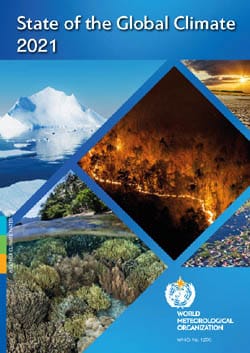
Four key climate change indicators – greenhouse gas concentrations, sea level rise, ocean heat and ocean acidification – set new records in 2021. The WMO State of the Global Climate in 2021 report confirms that the past seven years have been the warmest seven years on record. 2021 was “only” one of the seven warmest because of a La Niña event at the start and end of the year. This had a temporary cooling effect but did not reverse the overall trend of rising temperatures. The average global temperature in 2021 was about 1.11 (± 0.13) °C above the pre-industrial level.
Criticizing “the dismal litany of humanity’s failure to tackle climate disruption,” United Nations Secretary-General António Guterres used the publication of the WMO flagship report to call for urgent action to grab the “low-hanging fruit” of transforming energy systems away from the “dead end” of fossil fuels to renewable energy.
The report, which will be used as an official document for the UN Climate Change negotiations known as COP27, taking place in Egypt later this year.
Key Messages of the 2021 report
 Greenhouse gas concentrations reached a new global high in 2020, when the concentration of carbon dioxide (CO2) reached 413.2 parts per million (ppm) globally, or 149% of the pre-industrial level. Data from specific locations indicate that they continued to increase in 2021 and early 2022, with monthly average CO2 at Mona Loa in Hawaii reaching 416.45 ppm in April 2020, 419.05 ppm in April 2021, and 420.23 ppm in April 2022.
Greenhouse gas concentrations reached a new global high in 2020, when the concentration of carbon dioxide (CO2) reached 413.2 parts per million (ppm) globally, or 149% of the pre-industrial level. Data from specific locations indicate that they continued to increase in 2021 and early 2022, with monthly average CO2 at Mona Loa in Hawaii reaching 416.45 ppm in April 2020, 419.05 ppm in April 2021, and 420.23 ppm in April 2022.
The global annual mean temperature in 2021 was around 1.11 ±0.13 °C above the 1850-1900 pre-industrial average, less warm than some recent years owing to cooling La Niña conditions at the start and end of the year. The most recent seven years, 2015 to 2021, are the seven warmest years on record.
Ocean heat was record high. The upper 2000m depth of the ocean continued to warm in 2021 and it is expected that it will continue to warm in the future – a change which is irreversible on centennial to millennial time scales. All data sets agree that ocean warming rates show a particularly strong increase in the past two decades. The warmth is penetrating to ever deeper levels. Much of the ocean experienced at least one ‘strong’ marine heatwave at some point in 2021.
Ocean acidification. The ocean absorbs around 23% of the annual emissions of anthropogenic CO2 to the atmosphere. This reacts with seawater and leads to ocean acidification, which threatens organisms and ecosystem services, and hence food security, tourism and coastal protection. As the pH of the ocean decreases, its capacity to absorb CO2 from the atmosphere also declines. The IPCC concluded that “there is very high confidence that open ocean surface pH is now the lowest it has been for at least 26,000 years and current rates of pH change are unprecedented since at least that time.”
Global mean sea level reached a new record high in 2021, after increasing at an average 4.5 mm per year over the period 2013 -2021. This is more than double the rate of between 1993 and 2002 and is mainly due to the accelerated loss of ice mass from the ice sheets. This has major implications for hundreds of millions of coastal dwellers and increases vulnerability to tropical cyclones.
Cryosphere: Although the glaciological year 2020-2021 saw less melting than in recent years, there is a clear trend towards an acceleration of mass loss on multi-decadal timescales. On average, the world’s reference glaciers have thinned by 33.5 meters (ice-equivalent) since 1950, with 76% of this thinning since 1980. 2021 was a particularly punishing year for glaciers in Canada and the US Northwest with record ice mass loss as a result of heatwaves and fires in June and July. Greenland experienced an exceptional mid-August melt event and the first-ever recorded rainfall at Summit Station, the highest point on the ice sheet at an altitude of 3 216 m.
Exceptional heatwaves broke records across western North America and the Mediterranean. Death Valley, California reached 54.4 °C on 9 July, equalling a similar 2020 value as the highest recorded in the world since at least the 1930s, and Syracuse in Sicily reached 48.8 °C. The Canadian province of British Columbia, reached 49.6 °C on 29 June, and this contributed to more than 500 reported heat-related deaths and fueled devastating wildfires which, in turn, worsened the impacts of flooding in November.
Flooding induced economic losses of US$17.7 billion in Henan province of China, and Western Europe experienced some of its most severe flooding on record in mid-July associated with economic losses in Germany exceeding US$20 billion. There was heavy loss of life.
Drought affected many parts of the world, including the Horn of Africa, Canada, the western United States, Iran, Afghanistan, Pakistan and Turkey. In sub-tropical South America, drought caused big agricultural losses and disrupted energy production and river transport. The drought in the Horn of Africa has intensified so far in 2022. Eastern Africa is facing the very real prospect that the rains will fail for a fourth consecutive season, placing Ethiopia, Kenya and Somalis into a drought of a length not experienced in the last 40 years. Humanitarian agencies are warning of devastating impacts on people and livelihoods in the region.
Hurricane Ida was the most significant of the North Atlantic season, making landfall in Louisiana on 29 August, with economic losses in the United States estimated at US$75 billion.
The ozone hole over the Antarctic was unusually large and deep, reaching its maximum area of 24.8 million km2 (the size of Africa) as a result of a strong and stable polar vortex and colder than average conditions in the lower stratosphere.
Food security: The compounded effects of conflict, extreme weather events and economic shocks, further exacerbated by the COVID-19 pandemic, undermined decades of progress towards improving food security globally. Worsening humanitarian crises in 2021 have also led to a growing number of countries at risk of famine. Of the total number of undernourished people in 2020, more than half live in Asia (418 million) and a third in Africa (282 million).
Displacement: Hydrometeorological hazards continued to contribute to internal displacement. The countries with the highest numbers of displacements recorded as of October 2021 were China (more than 1.4 million), the Philippines (more than 386 000) and Viet Nam (more than 664 000).
Ecosystems: including terrestrial, freshwater, coastal and marine ecosystems – and the services they provide, are affected by the changing climate and some are more vulnerable than others. Some ecosystems are degrading at an unprecedented rate. For example, mountain ecosystems – the water towers of the world – are profoundly affected. Rising temperatures heighten the risk of irreversible loss of marine and coastal ecosystems, including seagrass meadows and kelp forest. Coral reefs are especially vulnerable to climate change. They are projected to lose between 70 and 90% of their former coverage area at 1.5 °C of warming and over 99% at 2 °C. Between 20 and 90% of current coastal wetlands are at risk of being lost by the end of this century, depending on how fast sea levels rise.


